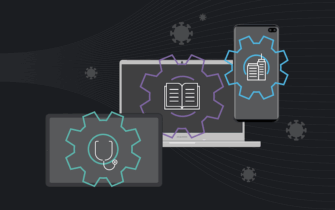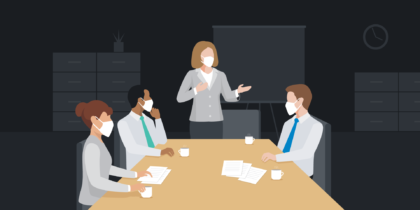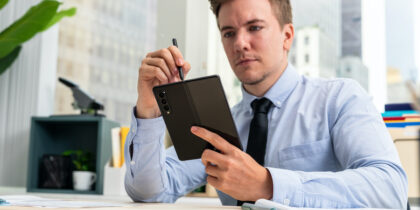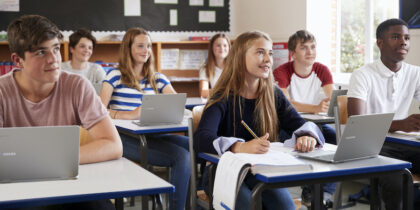Editor’s Note: This conversation is part of our ongoing “Future State Of” series. It has been edited for length and clarity.
Like most economic sectors, corporate America was upended by the COVID-19 crisis. It required the majority of nonessential workers to transition their kitchens and bedrooms into makeshift offices and had many concerned about how the workforce could keep business moving from home. However, organizations quickly found that employees were not only maintaining productivity but actually working more than ever — an average 48.5 minutes more per day.
Without the structure of a commute and a separation of home and office, the lines between personal and professional lives have become blurrier than ever. And with 44 percent of employees continuing to work from home, there is a clear need for solutions that help remote workers reclaim balance. Taher Behbehani, GM and SVP of Samsung B2B, sits down with Ashley Whillans, author of the new book, “Time Smart: How to Reclaim Your Time and Live a Happier Life,” and assistant professor at Harvard Business School, to discuss work-life boundaries in the next normal of remote work.
Taher Behbehani: Hi, Ashley. Thanks for speaking with me today. Many people feel the new work-from-home dynamic amounts to long hours and burn out. So, what happened? What do you think changed that we hadn’t planned for?
Ashley Whillans: Working from home has placed a lot of demands on individual employees for a myriad of different reasons. One of the most interesting reasons that I’ve come across in my research is this idea that we’re losing the natural breaks, boundaries and transitions that we used to have when we were commuting to the office. Because work from home is new for many of us, we’re not very good at scheduling in these breaks, routines and rituals to help us transition from work to personal life, and from personal life back to work. I used to always talk about the commute as something I dreaded, but it does have the silver lining that it would help us transition and give us a chance to plan our day ahead. In the absence of having a commute, that time that we would spend commuting that would provide an opportunity to have leisure goes missing in virtual work, and we end up filling it with more meetings.
TB: So, what can we as managers, and what can we as technologists, do to bring back some level of time management?
AW: One thing you can do as managers, or as leaders, is to put a commute time in your employees’ calendars that cannot be moved and that no meetings can be scheduled into. Research suggests that the average commute time that still feels great and beneficial is about 16 minutes. So, putting a half of an hour hold at the beginning of the day to “commute” can be beneficial. That commute could look like a walk around the block or extra time with your kid in the morning. It doesn’t really matter what that time is filled with as long as it’s up to an employee’s discretion to spend that time however they want to as a way to transition mentally from personal life into the workday at the beginning of the day.
Emerging changes from the pandemic era
See key learnings and statistics from the Future State of Business 2020 survey and report. Read Here
Managers can similarly use technology to encourage work-life separation at the end of the workday. Having clear rituals and clear boundaries at the end of the day is really important. While we always were on before, there’s a sense that we always always need to be on now. Other important strategies right now include building a ritual at the end of the workday, creating strong norms and holding each other accountable to not check email or meet after work hours.
TB: What are the principles of time management, given your research? Give me the fundamentals, the framework that we should take away.
AW: My book focuses on the traps that make us feel like we have too many things to do and not enough time in the day to do them, which is 80 percent of working Americans today. I then provide a list of personal strategies that individuals can try to live a happier, more time-affluent life. Our relationship with technology, the “mere urgency” effect (when we feel stressed we focus on urgent activities — like our inboxes — over important activities), an over-focus on money (vs. leisure) and “busyness as a status symbol” are key ingredients that we need to be aware of personally and identify for ourselves.
In terms of strategies, I talk about three primary strategies in the book: finding time, funding time and reframing time. The first strategy, this idea of finding time, is that it’s easy to get lost in social media or go down a rabbit hole of work that we weren’t necessarily intending to. So, this first idea is about becoming more mindful of the time we waste on unintentional activities.
The second strategy is buying time. If you find yourself working on unimportant, nonurgent tasks, you have to ask yourself, why am I doing this? Could I pay to get rid of it? You want to be thinking about your time use as a portfolio. You want to maximize positive and meaningful activities and minimize unpleasant and negative activities that are not moving you toward your major goals in life. This idea of funding time is using discretionary income to have more and better time, such as housecleaning, or childcare services, or ordering takeout. This strategy has benefits for well-being and stress all over the world, no matter how much money you make. I often get pushback on this point — isn’t this just for the affluent? And during COVID, we’ve found that buying time is particularly good for working parents, unsurprisingly, even those who make less than $40,000 in household income per year.
Finally, the third strategy is this idea of reframing time. We have research showing that when you reframe some of the drudgery or administrative work that so many of us have to do in our jobs as a way to help your organization meet its mission-critical goals or to help a peer get ahead on their own work, that this can help us feel less stressed and happier about having to complete these tasks.
TB: What are the tools you use that you think are absolutely essential?
AW: There are a lot of tech and nontech tools you can use to manage your schedule. The way that we navigate our email and alerts are particularly important. We need to set up joint calendars and create time blocks at the team level. It is not enough to manage our individual calendars. We also have to manage time at a collective level so that we are not constantly interrupting each other or distracting each other with alerts, and so we set up a very clear cadence of our team’s workday.
Another strategy that I think is very important is writing down your most important tasks at the beginning of the week. Often, we get to the end of the week and we haven’t moved any of our big rocks. We haven’t done any of the most important work on our schedule. Focusing and prioritizing on that one task you need to get done and working at it aggressively from the very start of the day, and not stopping the workday until you get that task done is crucial.
TB: Go back to the idea of money versus productivity. How do I gauge what’s right for me?
AW: Something I talk about in the book to help people think very concretely about the happiness gains they could get from making time-related choices is to account for their time as deliberately and carefully as they account for their money. This is one reason so many of us feel time poor: The value of $100 is very clear to us, however the value of an extra 30 minutes of leisure is less clear.
TB: How do you know if you are overexerting your team or if they’re at the right level?
AW: I would see how many unused vacation days there are on your team, and who are those vacation days not being used by. It seems counterintuitive, but people who feel extremely stressed, who are working on teams that are burning hot, are the ones that don’t want to let their colleagues down and may be the least likely to take vacation.
I would also look at the number of mandatory social hours that you have. Can you cut those down? Can you make them a 15-minute check-in as opposed to an hour and a half Pictionary game every week?
TB: Thank you, Ashley. This has been excellent.
AW: Great, thank you so much. It was a wonderful conversation.
Discover how Samsung’s solutions are simplifying productivity for employees looking to balance their personal lives with remote work. And keep up to date with the latest announcements and insights by following Taher Behbehani on Twitter.













